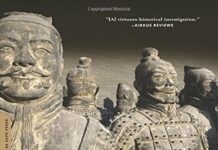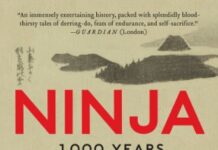
Ebook Info
- Published: 2014
- Number of pages: 352 pages
- Format: PDF
- File Size: 12.90 MB
- Authors: John Man
Description
The definitive history of the Samurai, by acclaimed author of Ninja: 1,000 Years of the Shadow Warrior“One could ask for no better storyteller or analyst than John Man.” —Simon Sebag Montefiore, author of Jerusalem: The Biography The inspiration for the Jedi knights of Star Wars and the films of Akira Kurosawa, the legendary Japanese samurai have captured modern imaginations. Yet with these elite warriors who were bound by a code of honor called Bushido—the Way of the Warrior—the reality behind the myth proves more fascinating than any fiction. In Samurai, celebrated author John Man provides a unique and captivating look at their true history, told through the life of one man: Saigo Takamori, known to many as “the last samurai.” In 1877 Takamori led a rebel army of samurai in a heroic “last stand” against the Imperial Japanese Army, who sought to end the “way of the sword” in favor of firearms and modern warfare. Man’s thrilling narrative brings to life the hidden world of the samurai as never before.
User’s Reviews
Reviews from Amazon users which were colected at the time this book was published on the website:
⭐I believe I own, and have read, all of Mr. Man’s books. This one was not a disappointment.I did not realize, when I ordered the book, that it was about Saigo Takamori, but it would have made no difference, I would have ordered it anyway.This is a well-written book on the history of the Samurai, how they came to be, and how they came to cease. Long interested in Bushido, the Way of the Warrior, I have read several books on the subject and this book was the most easily acceptable of them all.When John Man uses footnotes, and he does, they are where they belong, at the bottom of the page, not somewhere in the back of the book. That alone earns him gold stars in my book!Saigo Takamori, the last samurai, was a man of contradictions. When the Meiji period began, he did what he could to help it, even though it went against the Bushido he loved. He loved his Emperor above all else, and led a rebellion against him. A samurai to the bone, when the end came, he lost his head. He lost his battle. He became a hero to the people.If you are at all interested in the history of Japan, the Tokugawa’s (Shogun), Bushido, and Saigo Takamori, this is the book to read. Well researched, well-written, easily accessible by the non-scholar. And when you finish reading this book, leave your review, and then read his other books.
⭐Did know very little of Japanese history, but having traveled attempt that country it is quite inevitable to avoid getting captivated bucolic stories and traditional. The Samurai was one of those. This book gives a different perspective of reality compared to the myth.
⭐Very detailed accounts of battles in the beginning of the meiji restoration. Not fully what was expected of the last samurai but still great read.
⭐I maintain a library for a Natural Science Museum where we have a temporary exhibit of Samurai swords, armor etc. This book gives our docents the background information necessary to talk knowledgably about the Samurai way of life.
⭐good book
⭐At times it felt like I was listening to a teenage girl telling me a story about her day, not in chronological order and doubtful much of it was the best version of the truth. Would not recommend.
⭐SAMURAI: THE LAST WARRIOR, John ManThis book is a semi-biographical history of the creation and early years of the Meiji state, which lasted from 1868 to the Meiji Emperor’s death in 1912. The biographical narrative picks up steam after lengthy but interesting introductory material, and relates to Saigo Takamori – sometimes known as “The Last Samurai”. Saigo was born into a low-ranking samurai family in the Satsuma domain (at the southwestern tip of Japan proper, on the island of Kyushu). He rose to become a key figure in the quasi-revolution which ended 265 years of shogunal rule and restored the Emperor to power (the “Meiji Restoration”). Ironically, Saigo’s life was ended by the very Imperial army he helped create.The story of Saigo is important to understanding Japanese history in the second half of the 19th century, and the author covers aspects of Saigo’s life which generalized histories may omit – in favor of total focus on his key role in the 1877 Satsuma Rebellion. Saigo met his end in that rebellion, which was the last gasp of protest against a modernizing Meiji state.But it is the Satsuma Rebellion – the Meiji war against Satsuma samurai who refused to accept the new order – for which Saigo is best known. The great irony of this brief war is that the samurai rebels revered the emperor whose troops they fought. Their goal was a reversal of policies for which they blamed the emperor’s advisors rather than the emperor himself.The Satsuma Rebellion handed the Imperial Army an opportunity to test its real-world capabilities on a significant scale for the first time, and it was not found wanting. Contrary to Satsuma samurai expectations, the emperor’s new, largely conscript army with its Western weaponry and far superior numbers crushed the rebellion. Overwhelming success in this war emboldened the government, and foreshadowed the aggressive, imperialist moves which lay in the decades to come. But in one more irony, the war made Saigo as rebel a revered figure throughout Japan. The author devotes his last chapter to explaining how that came about. But anyone who knows the 47 Ronin story will readily understand how a heroic, selfless “traitor” can attain mythic status in Japan.John Man’s excellent explanation of the Satsuma Rebellion’s genesis, along with that of the earlier, little-known but significant Boshin War, are, in my view, his major contributions to readers interested in the Meiji Era. His blow-by-blow account of the rebellion’s battles may be of more interest to military enthusiasts than to the general reader.Much of the material in this book is adequately covered elsewhere, but I’ll give the author this: he writes with a degree of clarity which shows unusual respect for his readers. This volume is well worth reading for its concise but meticulous account of the pivotal events which are its focus.
⭐Excellent portrait of a man’s life that has influenced a culture so focused on its honor. This is an excellent introduction into the mindset of a culture.
⭐difficult reading – very academic style. I have enjoyed several other books by JM
⭐First rate
⭐Excellent book good condition
⭐This book was actually bought as a gift for someone else but I’ve been told that it’s a really good read and well written.
⭐Very interesting.Well developed subject
Keywords
Free Download Samurai: A History (P.S.) in PDF format
Samurai: A History (P.S.) PDF Free Download
Download Samurai: A History (P.S.) 2014 PDF Free
Samurai: A History (P.S.) 2014 PDF Free Download
Download Samurai: A History (P.S.) PDF
Free Download Ebook Samurai: A History (P.S.)





